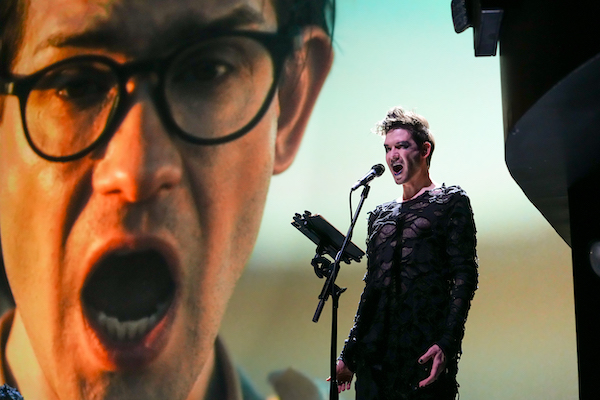Opera Philadelphia’s deafening “Black Lodge” mix upends world premiere

Timur performs with accompanying video in the live world premiere of David T. Little’s Black Lodge at Opera Philadelphia. Photo: Steven Pisano
Festival O22, a fortnight of performances and film screenings presented by Opera Philadelphia, came to a close Sunday. In the evening was the second and final performance of David T. Little’s Black Lodge, a new opera given its world premiere at the Philadelphia Film Center. Created first in 2021 as a film, this new production featured live performers accompanying a screening of the film under dramatic lighting.
Gothic horror stories have long provided operatic thrills, from Weber’s Der Freischütz and Wagner’s Flying Dutchman to Britten’s The Turn of the Screw and Birtwistle’s The Minotaur. The goal of Anne Waldman’s verbose libretto here is to evoke the worlds of more recent horror writers, including Antonin Artaud’s theater of cruelty, David Lynch’s Twin Peaks (which gave Little the opera’s title), and the drug-addled tales of William S. Burroughs.
Spoiler alert: the story does not make a whole lot of sense, told as it is in a sort of hallucinatory loop of flashbacks and dream vistas. It follows a man we are told is a writer: he wears a suit and has a typewriter. The man, at the end of a night of drinking and heroin use, shot and killed a woman he loved (something that actually happened to Burroughs). In a vivid waking nightmare, the man relives the guilt of this act, tormented in a cycle of bizarre images and scenes.
In a pre-performance talk, Little said that the opera combined all of his musical interests, as a musician who is both a classical composer and a drummer. He was inspired by the voice of Timur, the star of this performance and the leader of a glam rock band called Timur and the Dime Museum, to create the daunting part of The Man. For the opera’s grueling 70-minute duration, Timur’s voice was put through its many colors: baritonal growls, tender countertenor falsetto, and raucous tenor shriek.
The violent sounds of heavy metal, from a jump scare-inducing opening blast, signified the writer’s horror at his own murderous act. Timur and the Dime Museum—Hannah Dexter on bass, Andrew Lessman on drums, Matthew Setzer on guitar, and Milo Talwani on keys and electronics—gave this driving music a nauseating edge. At the loudest moments, the volume of the amplification was simply painful (blame sound designer Garth MacAleavey, who should dial it back for those of us who still need our hearing).
For contrast, especially in happier memories, Little turned to a string quartet, played in the film by the Isaura String Quartet. The Opera Philadelphia String Quartet—violinists Luigi Mazzocchi and Elizabeth Kaderabek, violist Yoshihiko Nakano, and cellist Jennie Lorenzo—were impossible to hear most of the time, even amplified. Their sound came out only in softer arias like “My childhood was,” as they accompanied the Man’s nostalgic recollection of his youth.
The work made one major misstep. At the moment when the gun was fired, the film (directed by Michael Joseph McQuilken and produced by Beth Morrison Projects) became an inane cartoon for a few minutes. All of the cumulative horror and creepiness, which should have come to a disturbing boil at this point, was instantly deflated. This sequence was less Artaud than 90s music video in its associations, turning to the kitsch, comic book side of the horror genre.
Anne Waldman’s libretto is scattershot, even though the librettist acknowledged in the pre-performance talk that she had written far more than Little ended up using. The work abounds in confounding imagery. A shiny green apple recalls the surrealist paintings of René Magritte. The otherwise unexplained appearance of a severed ear may have been inspired by Artaud’s infamous work on Van Gogh: both Artaud and Van Gogh were confined to asylums at various points in their lives.
The fractured duality of identity becomes a major theme. The Man sees himself as the Woman in several vignettes, being shot and then, with a bullet wound in his forehead, seated in a car. In another cartoonish touch, he cuts off one of his own fingers. The film comes to a striking climax, where the Woman appears at a bar in a sort of mirror image, becoming doubled and then folding back in on herself, in gestures echoed by the Man as he walks toward her.
To sync the live music to the film required all performers to follow a click track rather than having a conductor who could shape the work spontaneously. Unsurprisingly, this produced a mechanical feel in performance. Although required, to line up with recorded sounds from the film that were mixed with live sounds, this also added to the sense of desperate entrapment.
Little has created something innovative and disturbing, regrettably undermined at times by its own frivolity. Timur’s closing lines include the ostinato refrain, “All I want is out of here.” The feeling was mutual.
The film of Black Lodge, with its original sound, will be streamed on the Opera Philadelphia Channel, starting on October 21. operaphila.org


